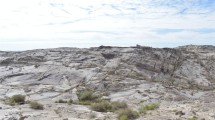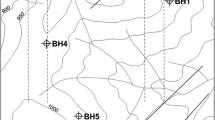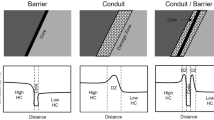Abstract
Up to now, field studies set up to measure field-saturated hydraulic conductivity to evaluate contamination risks, have employed small cylinders that may not be representative of the scale of measurements in heterogeneous media. In this study, a large adjustable ring infiltrometer was designed to be installed on-site directly on rock to measure its field-saturated hydraulic conductivity. The proposed device is inexpensive and simple to implement, yet also very versatile, due to its large adjustable diameter that can be fixed on-site. It thus allows an improved representation of the natural system’s heterogeneity, while also taking into consideration irregularities in the soil/rock surface. The new apparatus was tested on an outcrop of karstic fractured limestone overlying the deep Murge aquifer in the South of Italy, which has recently been affected by untreated sludge disposal, derived from municipal and industrial wastewater treatment plants. The quasi-steady vertical flow into the unsaturated fractures was investigated by measuring water levels during infiltrometer tests. Simultaneously, subsurface electrical resistivity measurements were used to visualize the infiltration of water in the subsoil, due to unsaturated water flow in the fractures. The proposed experimental apparatus works well on rock outcrops, and allows the repetition of infiltration tests at many locations in order to reduce model uncertainties in heterogeneous media.







Similar content being viewed by others
References
Abdel-Salam A, Chrysikopoulos VC (1996) Unsaturated flow in a quasi three-dimensional fractured medium with spatially variable aperture. Water Resour Res 32:1531–1540
Bear J (1979) Hydraulics of groundwater. McGraw-Hill, New York
Bear J (1993) Modeling flow and contaminant transport in fractured rocks. In: Bear J, Tsang CF, de Marsily G (eds) Flow and contaminant transport in fractured rock, vol 1. Academic Press, San Diego, pp 67–272
Binley AM, Cassiani G, Middleton R, Winship P (2002) Vadose zone flow model parameterisation using cross-borehole radar and resistivity imaging. J Hydrol 267(3–4):147–159
Bockgård N, Niemi A (2004) Role of rock heterogeneity on lateral diversion of water flow at the soil–rock interface. Vadose Zone J 3:786–795
Borgia GC, Bortolotti V, Masciopinto C (2002) Valutazione del contributo della porosità effettiva alla trasmissività di acquiferi fratturati con tecniche di laboratorio e di campo (Evaluation of effective porosity contribution to the transmissivity of fractured aquifer using laboratory and field techniques). IGEA Groundw Geoeng 17:31–43
Castiglione P, Shouse PJ, Mohanty B, Hudson D, van Genucthen MTh (2005) Improved tension infiltrometer for measuring low flow rates in unsaturated fractured rock. Vadose Zone J 4:885–890
Ciaranfi N, Pieri P, Ricchetti G (1988) Note alla Carta Geologica delle Murge e del Salento (Puglia Centro-Meridionale) (Notes on the geological map of Murge and Salento—Center-Southern Apulia). Mem Soc Geol It 41:449–460
de Gennes PG, Brochard-Wyart F, Quéré D (2002) Capillary and wetting phenomena—drops, bubbles, pearls, waves. Springer, New York (ISBN 0-387-00592-7)
Deiana R, Cassiani G, Kemna A, Villa A, Bruno V, Bagliani A (2007) An experiment of non invasive characterization of the vadose zone via water injection and cross-hole time-lapse geophysical monitoring. Near Surf Geophys 5:183–194
Hestir K, Long JCS (1990) Analytical expressions for the permeability of random two-dimensional Poisson fracture networks based on regular lattice percolation and equivalent media theories. J Geophys Res 95(B13):21565–21581
Loke MH, Barker RD (1996) Rapid least-squares inversion of apparent resistivity pseudosections using a quasi-Newton method. Geophys Prospect 44:131–152
Masbrucha K, Ferré TPA (2003) A time domain transmission method for determining the dependence of the dielectric permittivity on volumetric water content. An application to municipal landfills. Vadose Zone J 2:186–192
Masciopinto C (2005) Pumping-well data for conditioning the realization of the fracture aperture field in groundwater flow models. J Hydrol 309(1-4):210–228
Masciopinto C, Benedini M (1999) Unsaturated flow in fractures with anisotropic variable apertures. In: Proceedings of XXVIII IAHR—AIRH congress, 23–27 August, Graz, Austria
Nimmo JR, Schmidt KM, Perkins KS, Stock JD (2009) Rapid measurement of field-saturated hydraulic conductivity for areal characterization. Vadose Zone J 8(2):1–8
Pape H, Clauser C, Iffland J (1999) Permeability prediction based on fractal pore-space geometry. Geophysics 64(5):1447–1460
Pruess K, Tsang YW (1990) On two-phase relative permeability and capillary pressure on rough-walled rock fractures. Water Resour Res 26(9):1915–1926
Quarto R, Schiavone D (1994) Hydrogeological implications of the resistivity distribution inferred from electrical prospecting data from the Apulian carbonate platform. J Hydrol 154:219–244
Reitsma S, Kueper BH (1994) Laboratory measurement of capillary pressure-saturation relationships in a rock fracture. Water Resour Res 30(4):865–878
Reynolds WD, Elrick DE (1990) Ponded infiltration from a single ring: I. Analysis of steady flow. Soil Sci Soc Am J 54:1233–1241
Acknowledgments
This research was supported by the Italian Government (Regional Authority) under the 2007 Toxicological Data-Base studies.
Author information
Authors and Affiliations
Corresponding author
Appendix
Appendix
The unsaturated water flow in a vertical section can be described by the Richards’ equation:
where K fr(L/t) is the variable hydraulic conductivity as in the vertical fracture plane with variable apertures. It should be noted that, following Hestir and Long (1990), the fracture network in a vertical section xz (or yz) of a fractured rock can be assumed equivalent to a fracture lattice, as in a fracture with variable aperture. Consequently, K fr can be defined using the following equation (Bear 1993, p. 15)
where g(L/t 2) is the gravity acceleration; ρ(M/L 3) the water density; μ(N/L 2, centipoises) the dynamic water viscosity; \( \overline{{k_{\text{fr}} }} = \theta_{\text{s}} {\frac{{b(x, z)^{2} }}{12}} \) the saturated fracture permeability within which b(x, z) is the nodal aperture of the vertical fracture and θs the saturated water content; k(ψ)(–) the relative permeability coefficient and ψ(L) is the suction head. The coefficient k(ψ) is related to the water suction head (or to the water content, θ) by means of an unsaturated hydraulic conductivity function (Reitsma and Kueper 1994; Abdel-Salam and Chrysikopoulos 1996; Bockgård and Niemi 2004, p. 789) and it can be calculated using:
The field-saturated hydraulic conductivity, K fs is related to fracture hydraulic conductivity, K fr(ψ), at saturation and to the mean aperture of vertical fracture, by means of the permeability of the rock matrix and mean spacing between fractures of the outcrop (Hestir and Long 1990).
Equation 4 was solved by applying a finite difference grid in x and z. An iterative numerical method was used to solve the above equation and an infiltrated water mass balance check was carried out at every instant of simulation. Some numerical improvements of the Crank–Nicholson implicit method (Bear 1979) allowed an automatic increase (i.e., adjustment) of the temporal discretization step during numerical iterations in order to reduce the total computational time. A computational code calibrated in a previous work (Masciopinto and Benedini 1999) was then applied to reproduce the pressure head distributions during infiltration tests at the Altamura site. As boundary conditions at the topsoil, a variable pressure head versus time was imposed to simulate the water ring infiltration. The van Genucthen parameters for the retention curves considered for test #1 were α* = 1.11 m−1, m = 0.65, θr = 0.01 and θs = 0.99, respectively. It should be noted that α* was reassigned at the end of the simulation, when the output of the simulation fitted the real infiltrated water depth (about 1.5 m). The parameters for nodal aperture generation in the fracture plane (x, z) were mean of aperture 102.1 μm in x, 102.47 μm in z; standard deviations of Log aperture 0.34 in x and 0.49 in z, nugget 0.02 (in x and z), sill 0.10 (in x and z) and spatial correlation length 3 m in x and 2 m in z. The details describing the geo-statistical and computational methods used for fracture aperture generation in the vertical outcrop section are reported in other works (Masciopinto 2005; Pruess and Tsang 1990). Several simulations were carried out by considering different mean fracture apertures (i.e., the model parameters) in x and z. The best model solution (see Fig. 6b) was determined when the maximum simulated depth of infiltrated water was equal to 1.5 m, 80 min after the start of the infiltration into the ring. Thus, the corresponding model output, in terms of matric head distribution also enhanced the macroscopic capillary length of 0.90 m (or α* = 1.11 m−1) and the corresponding cutoff apertures \( \overline{b}_{\text{c}} \)(16.5 μm) defined by the Young–Laplace equation. This pressure head is clearly visible in Fig. 6b, as the contour line −0.90 m divides the zone of fracture filled only by air from that with larger apertures filled by water and air.
Rights and permissions
About this article
Cite this article
Caputo, M.C., De Carlo, L., Masciopinto, C. et al. Measurement of field-saturated hydraulic conductivity on fractured rock outcrops near Altamura (Southern Italy) with an adjustable large ring infiltrometer. Environ Earth Sci 60, 583–590 (2010). https://doi.org/10.1007/s12665-009-0198-y
Received:
Accepted:
Published:
Issue Date:
DOI: https://doi.org/10.1007/s12665-009-0198-y




